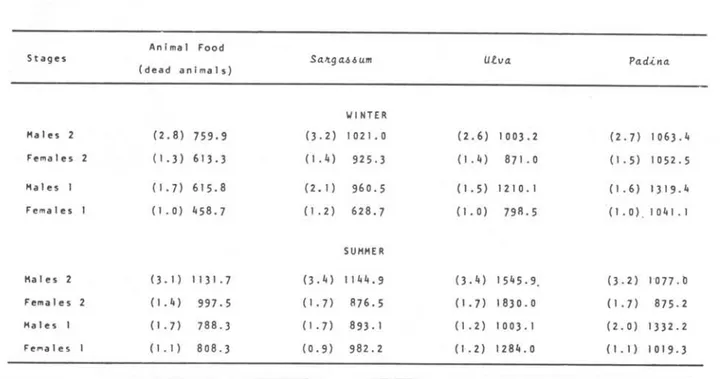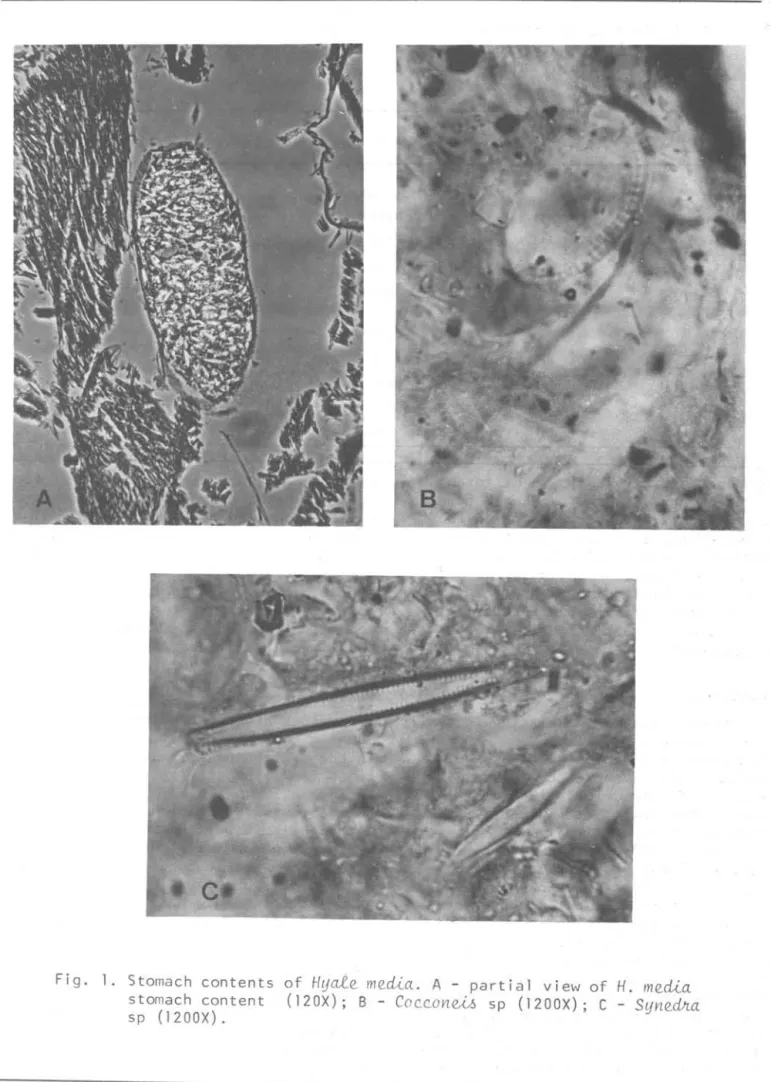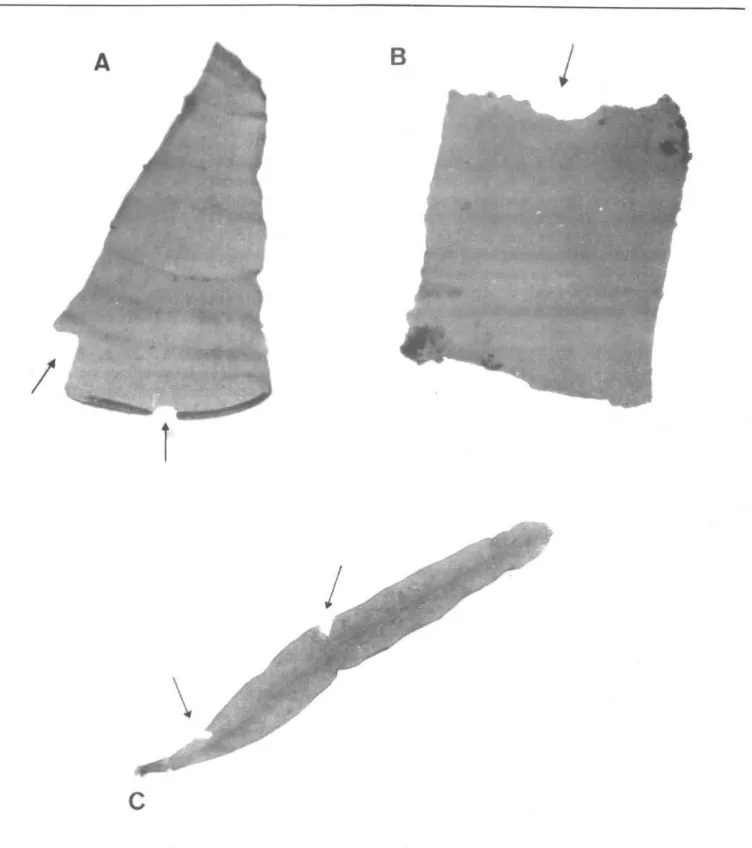801m Inst. oceanogr., S Paulo, 33(2): 193-199, 1985
FEEDING HABITS OF
Hyaie
med~a(DANAI
1853)(CRUSTACEA-AMPHIPODA)
Airton Santo TARARAM; Yoko WAKABARA
&
Hilda de Sousa Lima MESQUITAInstituto Oce~nogrãfico da Universidade de são Paulo (Caixa Posta1,9075, 01000 são Paulo, SP)
Synopsis
Feeding of maZes and femaZes of the Gammaridea
Hyale
me~aat mature and immature
stages were tested in Zaboratory experiments. Maaro and miarosaopia aZgae as weZZ
as dead
01'aUve animaZs were utiUzed as food.
This gammarid ia omnivorous"
feeding by predation" saavenging" browsing and saraping.
Feeding behaviour was
disaontinuous.
Padina
v~ek~~ewas more utiZized in winter and
Uiva
n~~ain
summer.
The feeding aativity of aZZ the animaZs showed great variabiZity in
reZation to the type of food.
Higher temperatures probabZy aaaount for the higher
aonsumption observed in summer.
Descriptors: Feeding behaviour, Experimental research, Developmental stages, Amphipoda,
Hyale
me~1 Itanhaem: SP, Brazil.Descritores: Hábitos aI imentares, Pesquisa experimental, Estádios de desenvolvimen-to, Amphipoda,
Hyale
me~, Itanhaem: SP.In trod uction
Studies on gammaridean feeding have been made by severa1 authors in the 1ast ten years (Moore, 1975; Kititsyna, 1975; Sweiss
&
Johnson, 1976; Brenneret
al'
l1976; Zimmerman
et
al'
l 1979; Vassalo&
Stee1e, 1980; Wi11oughby, 1983 and Moore
&
Francis, 1985).The impact of the associated fauna on a1gae and the factors interfering on herbivorous food preferences have been discussed in the 1iterature main1y by Nicotri (1977), Pomeroy
&
Levings(1980), Nicotri (1980), Braw1ey
&
Adey (1981), Shack10ck & Croft (1981), Price&
Hy11erberg (1982) and Shack10ck&
Doy1e (1983).
In the northen and southern shores of são Paulo State,
Hyale media
(Dana, 1853), Ta1itridea, is the most abundant amphipod 1iving on Sanga6~um p1ants, andshows a wide vertical distribution (Tararam
&
Wakabara, 1981; Tararamet
al.,
1981; Wakabaraet
al.,
1983;Tararam
et
al.,
in press). The present work reports the qua1itative resu1ts of 1aboratory studies onH. media
feeding.AJtea 06
inv~tiga;tionA1gae samp1es were co11ected at Praia do
Pubi. n.
636do
I~t.oeeanogJt. da
U~r.Poço, Itanhaem, in the southern coast of são Paulo State, Brazi1 (24°12'S
-46°47'W).
Praia do Poço is partia11y she1tered from wave action by rocks and stones where SaJtg~~um p1ants are very common.
Sang~~um ~tenophyUum and S. eymo~um
are abundant and
Uiva
n~~ata and Pa~na
v~ek~~ae occur in sma11erquantities. Associated to these a1gae, severa1 Gammaridea such as Cymad~a n~
io~a, E~etho~ b~ilie~~, Ei~mo
p~ peetinie~, Sunamp~oe
pelagiea
have been found, besides
Hyale media
(Wakabara
et
al.,
1983). During the investigation period, from January to August 1979, the mean sa1inity,disso1ved oxygen and water temperature recorded were 34.18%0, 5.00 m1/1 and 24.0 0C, respective1y.
Ma terial and Inethods
The macroa1gae SaJtga6~um ~tenophyUum,
Uiva
na6~ata, Pa~na v~ekeM~ae and the microscopic a1gaePhaeodaetyium
tJtieoJt-nutum, Skeletonema eMtatum, ChloJtella
sp, I~oeJty~~ sp were uti1ized as food
194
H. media, C!frtiadu..6a
~ilo.6a,EfLidhoniU6
bha.6ili~n6~ as we11 as fragments of
Decapoda Reptantia were offered as food to
H. media.
The experiments were performed with animal and p1ant food co11ected at the sampling sites ofH.
media
specimens.The plant substratum
(Sahga.6.6um)
was scrapped from the rock and irnrnediatly p1aced into containers with aerated seawater. In the 1aboratory, plants and their fauna were transferred to the aquarium (28 i capacity) with aerated seawater. The water was changed every 20 days approximately.Sahga.6.6um
plants when chopped off by garnrnarids wererep1aced periodical1y.
The anima1s utilized in the experi-ments were grouped according to their deve1opmenta1 stage and sex following the study of
H. media
lif e cycle (Leite, 1976). Stage 1 (males and females, general1y irnrnature) comprisedindividuals with 9 or 10 articles in antenna 1; stage 2 (mature males with large gnathopods, ovigerous fema1es) comprised individuals with 11 or 12 articles in antenna 1. The specimens were acclimated for about 48 hours, fo11owed by 12 hours of starvation. Three individuals of the same sex and in the same deve10pmenta1 stage were p1aced into 500 m1 containers with
filtered, continuously aerated seawater and covered wi th aluminum foi1 to avoid light effect. Temperature was
maintained at 21.1 ± 0.8°C in winter and 26.8 ± O.6°C in surnrner and salinity at
34.18 ±
0.2%
0 • Three replicates wereutilized for each group, surnrning 9 animals per group. The feeeding period was 22 hours. Fol1owing Lawton (1970), Zirnrnerman
et
al.
(1979), Shack10ck&
Croft (1981) and Shacklock
&
Doyle(1983) one control was utilized to avoid overestimating consumption by 10ss of food weight.
Starvation, alimentary periods and number of individuals necessary for adequate replication were determined in previous experiments. The amount of food ingested was obtained by evaluating the differences between the food weight before and after the feeding period. Data given in Table 1 are the mean values of ingestion experiments. The average standar error is Sx = 199.6.
In experiments with microalgae, aliquots of algal cul ture were placed
Bolm Inst. oceanogr., S Paulo,
33(2)~1985
into dark containers (500 m1) with filtered seawater. A f1ask, treated in the same way, but lacking amphipods, was considered as the controlo The quantity of ingested microa1gae was estimated by countings under a transmitted 1ight microscope, before and after the feeding period.
Stomach contents of
H. media
specimens, fixed in 4% forma1dehyde, were a1so ana1ysed under a transmitted
light microscope.
Results
Sahga.6.6um
p1ants utilized as substratum were comp1et1y reduced to fragments bythe
H.
me~a activity, requiring newp1ant supplies to the aquarium.
Hyale media
accepted al1 the food offered excepting microalgae. Adults proved to be agile, efficient hunters and carriedAtdem,,[a
sp and harpacticoidcopepod into the mouth by quick appendage movements. Scavenging was observed when pieces of Decapoda and dead garnrnarideans were ingested.
Scraping behaviour was attributed to
H.
media
because some epiphytic diatoms were found in the stomach contents ofthe specimens samp1ed from Praia do Poço (Fig. 1). Co~~on~ .6~uteffum
was the major diatom and
Synedha
sp,Licmohpha
sp, A~hnante.6 sp andUavi~ula sp. were less frequento The
identification of these genera to species level was impossible because specimens were either decomposed or broken. Decomposed tissues of rnacro-a1gae and crustacean setae in the . stomach contents of
H. media
were a1so observed, as wel1 as unidentifiedamorphous material. Browsing was noted when
Sahga.6.6um .6-tenophyUum, Uiva 6a.6- .
ua-ta
andPacüna
vi~keh.6iae wereingested. Figure 2 shows three macro-algae scraped at the surface by
H.
media.
TARARAM
et
al.:
Feeding habits:Hyale media
195Table I. Mean values of
Hyale media
day) in winter and summer. experimental animaIsAnimal Food
food ingestion (~g of food/individual/
( ) =
mean weight in mg ofPad.ina
Stages SaJtga.l.lum
(dead animaIs) utva
Males 2
Females 2
Males I
Females I
Males 2
Females 2
Males I
Fe ... ales I
(2.8) 759.9
(1.3) 613.3
(1.7) 615.8
(1.0) 458.7
0.1) 1131.7
(1.4) 997.5
(1.7) 788.3
(I. I ) 808.3
0.2) (1.4) (2. I) (1.2) 0.4) (1. 7) (1.7) (0.9)
the case of individuaIs in different developmental stages, females 2 seem to have ingested greater amounts of food than females 1, excepting S~tgah~um and
Padina
in summer. The high standard error found was partially due to the great variability in weight of the experimental animaIs and to the fact thatH.
me~ does not utilize food continuously.Discussion
The damage caused by gammarids to the sheltering plants, as
H. media
to theSangah~um in the present experiments,
has been also observed by several
authors (Nicotri, 1977, 1980; Brawley
&
Adey, 1981; Shacklock
&
Croft, 1981; Shacklock&
Doyle, 1983).Dennel (1933), Anraku
&
Omori (1963), Agrawa1 (1964) and McGrouther (1983)suggested a close re1ationship between feeding habits and mouthpart structure of some species.
H. media
mouthparts are not those of a filter-feeding species, because of their short and non-plumose setae. This fact was also observed inH.
nupieola
by McGrouther(op.
cLt.).
The strong mandibular molar inH. media
would allow the trituration of solid food and the partially broken diatoms in its stomach content is an evidence of this characteristic.W I NTE R 102 I. O
925.3 960.5 628.7 SUMMER 1144.9 876.5 893. I 982.2
(2.6) 1003.2
(1.4) 871.0
(1.5) 1210.1
(1.0) 798.5
0.4) 1545.9.
(1.7) 1830.0
(1.2) 1003.1
(1.2) 1284.0
(2.7) 1063.4
(1.5) 1052.5
(1.6) 1319.4
(1.0) , 1041.1
0.2) 1077.0
(1.7) 875.2
(2.0) 1332.2
(LI) 1019.3
Epiphytic diatoms constitute one of food items ingested by gammarids according to results obtained by D'Antonio (1985). Behbehani
&
Crocker (1982) in laboratory experiments observed O~eh~tia plate~~scraping diatoms off glass surfaces. The present results indicate that
H.
media
is omnivorous, feeding by predation, scavenging, scraping and browsing. Gammaridea, specifical1y talitrids studied by Agrawa1 (1964), Bowers (1964), Behbehani&
Crocker(1982) and Moore
&
Francis (1985), are omnivorous although their food spectra usually consists mainly of macroalgae. In the present case, animal food was the least food item utilized byH. media,
but predation was also observed when it
hunted living copepod and ~~ sp.
Although it is well known that talitrids feed on food of animal origin, the
question wether it is uti1ized a1ive or dead remains unsolved. O~eh~~a
gamma-~ett~ according to Moore
&
Francis(1985) does not eat living animaIs.
O. eavimana
(Dorsman, 1935 apud Moore&
Francis, 1985) and
O.
plate~~(Behbehani
&
Crocker, 1982) wereobserved eating 1iving animaIs, a fact regarded as aberrant or an occasiona1 behaviour.
196 Bolm Inst. oceanogr., S Paulo, 33(2),1985
Fig. 1. Stomach contents of /-IljCLte mecü.a. A - partial view of /-I. mecü.a
stomach content (120X); B - COC.C.OVleM, sp (1200X); C - SljVledJr..a
TARARAM ~ o~.: Feeding habits:
Hyaie media
197B
j
\
c
Fig. 2. A -
P({diVl.a;
B ;,.Uiva
and C -SaJtgaMum
after grazing period. Arrows indicate damaged sites byHyale media.
(1983). Fish & Preece (1970) assured that the variation in alimentary habits may be dúe to the different quantities of reserved food and/or different age of specimens with the same weight.
The qualitative difference o~
ingestion in winter and summer
(PadiVl.a
is more utilized in winter and
Uiva
1n summer) may be attributed to thedifferent nutritional values of the food
plants; Nicotri (1980) pointed out that the specimens graze faster on food containing more organic material.
The general higher consumption of food in summer may be related to a higher mean weight of the animaIs and higher temperatures occurring in this period; Kititsyna (1975) showed that the rate of food ingestion by POVl.togammah~
198
weight and temperature.
On the other hand, alga by itse1f may not meet the nutritiona1 requirements of Gammaridea which need a comp1ementary food. Vassalo
&
Stee1e (1980) assuredthat Gammah~ t~encian~ requires
animal food as we11 as a1gae for a rapid growth and maturation.
For the sake of data interpretation, one shou1d remember that in nature, due to the re1ative1y great amount and diverse types of food assumed to be avai1ab1e, the predator may utilize numerous preys. In 1aboratory experiments as in the present case, preys are genera11y 1imited in quantity and qua1ity. In addition, the predators are confined to a sma11 water volume with one food type on1y, as discussed by Price
&
Hy11erberg (1982).Acknowledgements
We wou1d 1ike to express our gratitude to Drs E. C. Oliveira Filho and E. J. de Paula; Drs M. B. B. Kutner and I. R. Oliveira for the a1gae and diatoms c1assification, respective1y.
References
AGRAWAL, V. P. 1964. Studies on the physio10gy of digestion in O~Qh~tia
gamm~~a. Proc. zool. Soe. Lond.,
143:l33-141.
ANRAKU, M. & OMORI, M. 1963. Pre1iminary survey of the re1ationship between the feeding habit and the structure of the mouth-parts of marine copepods. Limno1. Oceanogr., 3(1):116-129.
BEHBEHANl, M. l. & CROKER. R. A. 1982. Eco10gy of Beach lhack in northern New Eng1and with specia1 reference to
O~Qh~~a ptaten6~. Estuar. cst1 Shelf Sei., 15:6ll-620.
BOWERS, D. E. 1964. Natural history of two beach hoppers of the genüs
O~Qh~toidea (Crustacea: Amphipoda) with reference to their complementaI distribution. Eco10gy, 45(4):677-696.
BRAWLEY, S. H. & ADEY, W. H. 1981. The effect of micrograzers on a1ga1
community structure in a coral reef microcosmo Mar. Bio1., 61:167-177 .
Bolm Inst. oceanogr., S Paulo, 33(2), 1985
BRENNER, D.; VALIELA, I.; RAALTE, Van C. D.
&
CARPENTER, E. J. 1976. Grazingby Tato~Qh~tia tongiQo~ on an
a1gae mat in a New Eng1and sa1t marsh.
J. exp. mar. Bio1. Eco1., 22(2):161-169.
D'ANTONIO, C. 1985. Epiphytes on the rocky intertida1 red alga
Rhodomela
t~x (Turner) C. Agardh: negative effects on the host and food for herbivores? J. exp. mar~ Bio1. Eco1.;
86:197-218.
DENNEL, R. 1933. The habits and feeding mechanism of the amphipod
Ha~to~~ ~en~ Slabber. J.
Linn. Soe. Lond., Zool., 38:363-388.
FISH, J. D.
&
PREECE, G. S. 1970. The ecophysio10gica1 comp1ex ofBathypo-~eia pito~a and
B. pelagiea
(Crustacea-Amphipoda). I. Respiration rates. Mar. Bio1., 5:22-28.
KITITSYNA, L. A. 1975. Feeding rates
of Pontogamm~~ ~ob~toid~ at
different temperatures. Hydrobio1.
J., 11 (1) : 35-40.
LAh/TON, J. A. 1970. Feeding and food energy assimi1ation in 1arvae of demse1f1y Py~~ho~oma
nymphula
(Su1z.). J. Anim. Eco1., 39:669-689.
LEITE, F. P. P. 1976. Estádios de crescimento e aspectos da reprodução de
Hyale media
(Crustacea, Amphipoda, Hya1idae) da fauna vági1 de S~ga6~umQymo~um. Dissertação de mestrado.
Universidade de são Paulo, Instituto Oceanográfico, 74p.
McGROUTHER, M. A. 1983. Comparison of feeding mechanisms in two intertida1 gammaridean, Hyal~
hupieula
(Haswe11)and P~aQ~op~ a~tnati~ (Haswe11)
(Crustacea-Amphipoda). Aust. J. Mar. Freshwat. Res., 34:717-726.
MOORE, J. H. 1975. The role of a1gae in the diet of A~~tf~ aq~Q~ L. and Gamm~~
pulex
L. J. Anim. Eco1., 44:719-730.MOORE, P. G. & FRANCIS, C. H. 1985. Some observations on food and feeding of the supra1ittora1 beach-hopper
TARARAM
et
al.:
Feeding habits:Hyale
me~a 199NICOTRI, M. E. 1977. The impact of crustacean herbivores on cu1tured seweed popu1ations. Aquacu1ture, 12:127-l36.
1980. Factors invo1ved in herbivore food preference. J.
exp. mar. Rio1. Eco1., 42:13-26.
POMEROY, W. M.
&
LEVINGS, C. D. 1980. Association and feeding re1ationships betweenEogammaJr.Uó
c.ontÍeJtvic.oiUó(Amphipoda, Gammaridea) and benthic a1gae on Sturgeon and Roberts Banks, Fraser River Estuary. Cano J. Fish. Aquat. Sei., 37:1-10.
PRICE, L. H. & HYLLEBERG, J. 1982. A1ga1-fauna1 interactions in a mat of
Uiva 6aóc.iata
in Fa1se Bay,Washington. Ophe1ia, 21:75-88.
SHACKLOCK, P. F. & CROFT, G. B. 1981. Effect of grazers on
ChondJtUó
C.WP!Min cu1ture. Aquacu1ture, 22:331-342.
- - - & DOYLE, R. W. 1983.
Contro1 of epiphytes in seaweed cu1tures using grazers . Aquacu1ture, 31:141-151.
SWEISS, J. J. & JOHNSON, M. G. 1976. Energy dynamics of two benthic crustaceans in relation to diet. J. Fish. Res. Bd Can., 33(11):2544-2550.
TARARAM, A. S.
&
WAKABARA, Y. 1981. The mobile fauna-especia11yGammaridea of
SMgaó-6um c.yr/10-6um.
Mar. Eco1. Prog. Ser., 5:157-163.
TARARAM, A. S.; WAKABARA, Y. & TAKEDA, A. M. 1981. Seasona1 variations of Amphip'oda ' 'Species 1iving on
SaJtCjaó-6um
in Itanhaem, são Pau1o-Brazi1.
In:
Seminário Regional de Ecologia, 29, Anais '" são Carlos, Universidade de são Carlos, Departamento de Ciên-cias Biológicas, p. 305-321.
& LEITE, F. P. P. (in press). Vertical
distribution of amphipods 1iving on a1gae of a Brâzi1ian intertida1 rocky shores. Crustaceana.
VASSALO, L. & STEELE, D. H. 1980. Surviva1 and growth of young
GammaJtUó iawJtenc.ianUó
Bousfie1d,1956, on different diets. Crustaceana, 6:118-125.
~.JAKABARA, Y.: TARARAM, A. S. & TAKEDA, A. M. 1983. Comparative study of
the amphipod fauna 1iving on
SMgaó-6um
of two Itanhaem shores,Brazi1. J. Crust. Bio1., 3(4):602-607.
WILLOUGHBY, L. G. 1983. Feeding behaviour of
GammMUó pulex
(L.)(Amphipoda) on
Nitefla.
Crustaceana, 44 (3): 245-250.ZIMMERMAN, R.; GIBSON, R. & HARRI~GTON,
J. 1979. Herbivory and detritivory among gammaridean amphipods from a Florida seagrass community. Mar. Biol., 54: 41-47.


